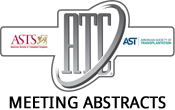2019 American Transplant Congress
Actions Speak Louder Than Labs – The Impact of Dialysis Compliance on Posttransplant Outcomes
*Purpose: Non-adherence is a modifable risk factor for poor posttransplant outcomes. While the factors contributing to posttransplant non-adherence are complex, noncompliance with the dialysis prescription…2019 American Transplant Congress
Response to Treatment in Kidney Recipients with Acute T Cell-Mediated Rejection: Major Impact of Inflammation in Sclerotic Cortical Parenchyma (i-IF/TA) and Donor-Specific Antibodies
Paris Translational Research Center for Organ Transplantation, Paris, France
*Purpose: The recent recognition of chronic TCMR phenotypes has fostered the need to better evaluate the response of acute TCMR to standard-of-care treatment.*Methods: Among 2905…2019 American Transplant Congress
Higher Level of Social Support is Associated with Higher Likelihood of Pursuit of Living Donor Kidney Transplant (LDKT)
*Purpose: LDKT is the optimal treatment for many patients with End Stage Kidney Disease (ESKD) , offering better clinical outcomes and quality of life. Studies…2019 American Transplant Congress
Primary Indications and Waitlist Status for Pediatric Living Donor Liver Transplants
*Purpose: Since 1989, living donor liver transplantation (LD) has been used for a selected population and has shown improved long-term graft survival. The aim was…2019 American Transplant Congress
Economic Impact of Donor Hepatitis C Kidney Transplantation: A Medicare Cost Analysis
*Purpose: In the era of highly effective direct-acting antiviral agents (DAAs), kidney transplant (KT) from Hepatitis C virus (HCV)-positive donors is increasingly considered as an…2019 American Transplant Congress
Plasmacytoid Dendritic Cell-Mediated Graft Prolongation Requires microRNA-181 and Semaphorin 4a
Stanford Univ School of Med, Stanford, CA
*Purpose: Dendritic cells (DCs) are antigen-presenting cells (APCs) important for initiating and coordinating the immune response. Plasmacytoid dendritic cells (pDCs) are a subset of DCs…2019 American Transplant Congress
Reduction In Early Readmission In Kidney Recipients – Outcomes At One Year With Standardized Intensive Follow Up
Glickman Urological and Kidney Institute CCF, Cleveland, OH
*Purpose: Kidney transplant recipients often experience frequent ED visits and high early hospital readmission (EHR) rates (within 30 days). We sought to decrease our preventable…2019 American Transplant Congress
Visceral Arterial Embolization – An Important Tool For Managing Blood Loss In Multivisceral Transplant Candidates With Portomesenteric Thrombosis
Duke University Medical Center, Durham, NC
*Purpose: Organ explant in multivisceral transplant (MVT) candidates is technically demanding associated with high volume blood loss. Visceral arterial embolisation (VAE) may reduce bleeding, but…2019 American Transplant Congress
Can Cardiac Risk Predictor Models Be Trusted in Kidney Transplant Recipients?
*Purpose: Kidney transplant recipients (KTR) bear a higher risk of developing cardiovascular disease due to comorbid conditions. Non-invasive cardiovascular risk stratification tools have not been…2019 American Transplant Congress
Hephaistos Study Outcome on Renal Function after 12 Month Everolimus Plus Reduced Tacrolimus in De Novo Liver Transplant Recipients versus Standard Tacrolimus
1Study Group, Hephaistos, Germany, 2Novartis Pharma GmbH, Nuernberg, Germany
*Purpose: The HEPHAISTOS study was designed to compare efficacy and safety of earlyuse of everolimus [EVR] combined with reduced tacrolimus [rTAC] versus Standard tacrolimus [TAC-C)…
- « Previous Page
- 1
- 2
- 3
- 4
- 5
- 6
- …
- 214
- Next Page »
